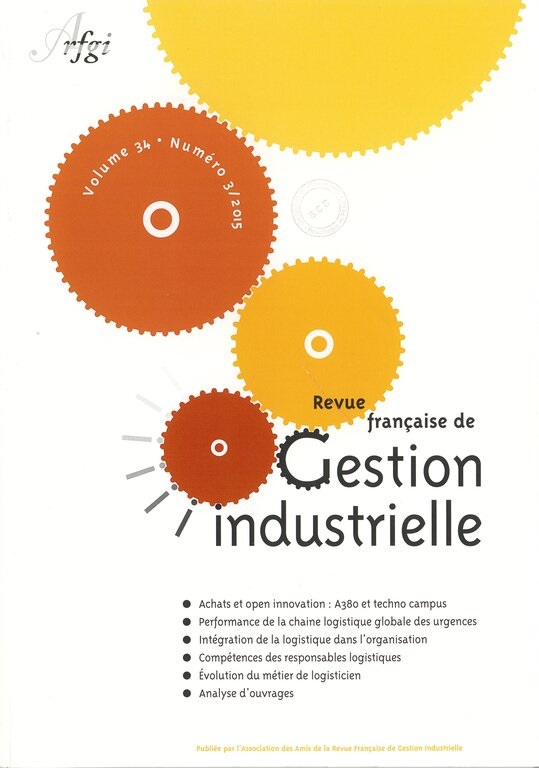De l'intégration de la logistique dans l'organisation aux organisations orientées logistiques
DOI :
https://doi.org/10.53102/2015.34.03.834Mots-clés :
stratégie, logistique, organisation, configurations, structureRésumé
S'inscrivant dans la lignée des travaux qui soulignent que les organisations peuvent s'orienter autour d'une fonction comme le "marketing", la "conception", le "projet", cet article a pour objet de montrer qu'une possibilité est également de s'orienter "logistique". Basé sur l'étude de deux organisations fortement orientées logistiques — IKEA et Médecin Sans Frontières l'article propose deux contributions. Premièrement, il clarifie le concept "d'organisation orientée logistique", qui renvoie à trois dimensions : la dimension offre, la dimension acteur, la dimension supply chain. Deuxièmement, il montre qu'orienter l'organisation vers la logistique est pertinent lorsque la logistique représente la part prépondérante des coûts de distribution des produits et/ ou l'élément central du service au client.
Références
Second Edition, Blackwell Publishers, Malden, MA, 318 pp.
Guba, E. G. and Lincoln, Y. S., (1989), Fourth generation evaluation. Newbury Park, CA, USA: Sage.
Harrison, A. and van Hoek, R. I., (2008), Logistics Management and Strategy: Competing Through the Supply Chain, Prentice Hall Financial Times.
Hatchuel A., Le Masson P., and Weil B., (2002), "From Knowledge Management to Design-Oriented Organisations", International Social Science Journal , Vol. 171, pp. 25-37. https://doi.org/10.1111/1468-2451.00356
Heskett, J., (1977) "Logistics–Essential to Strategy", Harvard Business Review, Vol. 55, No. 6, pp. 85-96.
Khan, O. and Creazza, A., (2009), "Managing the product design-supply chain interface: Towards a roadmap to the “design centric business”", International Journal of Physical Distribution & Logistics Management, Vol. 39, No. 4, pp. 301-319. http://dx.doi.org/10.1108/09600030910962258
Kiser, E., (1996), "The revival of narrative in historical sociology: What rational choice theory can contribute", Politics and Society, Vol. 24, No. 3, pp. 249-271. https://doi.org/10.1177%2F0032329296024003005
Kohn, J. W. and McGinnis, M. A., (1997a), "Logistics Strategy: A Longitudinal Study", Journal of Business Logistics, Vol. 18, No. 2, pp. 1-14. http://dx.doi.org/10.1002/j.2158-1592.2010.tb00136.x
Kohn, J. W. and McGinnis, M. A., (1997b), "Advanced Logistics Organization Structures Revisited", Journal of Business Logistics, Vol. 18, No. 2, pp. 147-162.
Lai, K.-H., (2003), "Market orientation in quality-oriented organizations and its impact on their performance", International Journal of Production Economics, No. 84, pp. 17–34. https://doi.org/10.1016/S0925-5273(02)00382-1
Lawrence P.R and Lorsch J.W., (1967), Organization and Environment. Managing differentiation and integration, Homewood, IL Irvin.
Lusch, R.F., (2011), "Reframing Supply Chain Management: a Service Dominant Logic Perspective", Journal of Supply Chain Management, Vol. 47, No. 1, pp. 14-18
Lusch, R.F., Vargo, S.V. and Tanniru, M., (2010), "Service, value networks and learning", Journal of the Academy of Marketing Science, Vol. 38, pp. 19–31 http://dx.doi.org/10.1111/j.1745-493X.2010.03211.x
Mather, H., (1992), "Design for logistics (DFL) – the next challenge for designers", Production & Inventory Management Journal, Vol. 33, No. 1, pp. 7-11.
McGinnis, M. A. and Kohn, J. W., (1990), "A Factor Analytic Study of Logistics Strategy", Journal of Business Logistics, Vol. 11, No. 2, pp. 41-63.
McGinnis, M. A. and Kohn, J. W., (1993), "Logistics Strategy, Organizational Environment and Time Competitiveness", Journal of Business Logistics, Vol. 14, No. 2, pp. 1-23.
McGinnis, M. A., Kohn, J. W. and Spillan, J. E., (2010), "A Longitudinal Study of Logistics Strategy: 1990– 2008", Journal of Business Logistics, Vol. 31, No. 1, pp. 217-235. http://dx.doi.org/10.1002/j.2158-1592.2010.tb00136.x
Miles, H. and Huberman, M., (1994), Qualitative Data Analysis: A sourcebook, Sage Publications, Beverly Hills, CA.
Mintzberg, H., (1976), The structuring of Organizations, Englewood Cliff, N-J Prentice Hall Morash, E. A., Dröge, C. L. M., and Vickery, S. K., (1996), "Strategic logistics capabilities for competitive advantage and firm success", Journal of Business Logistics, Vol. 17, No. 1, pp.1–22.
Payne, A. F., (1988), "Developing a Marketing-Oriented Organization", Business Horizons, Vol. 31, No. 3, pp. 46–53. https://doi.org/10.1016/0007-6813(88)90008-0
Payne, D., (2000), "Distribution-Based Logistics", Army Logistician. Januarv-Februarv, pp. 38-41.
Persson, G., (1991), "Achieving competitiveness through logistics", International Journal of Logistics Management, Vol. 2, pp. 1-11. https://doi.org/10.1108/09574099110804625
Porter M., (1985), Competitive advantage, Free Press, New-York.
Van Maanen, J., (1979), "The fact of fiction in organizational ethnography", Administrative Science Quarterly, Vol. 24, No. 4, pp. 539–550. http://dx.doi.org/10.4324/9781315241371-24
Van Wassenhove, L.N., (2006), "Humanitarian aid logistics: Supply chain management in high gear", Journal of the Operational Research Society, Vol. 57, pp. 475–489. http://dx.doi.org/10.1057/palgrave.jors.2602125
Voss, C., Tsikriktsis, N. and Frohlich, M., (2002), "Case research in operations management", International Journal of Operations & Production Management, Vol. 22 No. 2, pp. 195–219. http://dx.doi.org/10.1108/01443570210414329
Yin, R. (2003), Case study research: design and methods, Sage Publications, Thousand Oaks, Calif.
Numéro
Comment citer
Rubrique
Licence

Ce travail est disponible sous licence Creative Commons Attribution - Pas d’Utilisation Commerciale 4.0 International.











